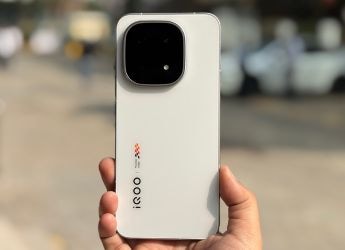- Home
- Others
- Others News
- Obama Administration Proposes That All New Cars Must Be Able to 'Talk to Each Other'
Obama Administration Proposes That All New Cars Must Be Able to 'Talk to Each Other'

Photo Credit: US Department of Transportation
The Obama Administration on Tuesday proposed a rule that would require all new cars to be able to communicate with other cars wirelessly, a move that advocates said could save lives, but that also raises privacy and hacking concerns among opponents.
Federal transportation officials, as well as many researchers and industry executives, see significant safety advantages, with the widespread installation of "vehicle-to-vehicle" or V2V technology. The wireless box could, for instance, tell a car to brake when another vehicle is about to run a red light.
The US Department of Transportation said the rule would be the first mandate of the technology worldwide.
Transportation Secretary Anthony Foxx said the new rule can "prevent hundreds of thousands of crashes" and "spare thousands of families in the future the pain of losing a loved one" in a collision. Foxx projected that up to 80 percent of crashes not involving alcohol or drugs could be eliminated or made less severe.
Last year, 35,092 people were killed on US roads.
Foxx estimated that it would take about a year for the public comment period. After that, automakers would have two years to put the technology in half their new cars and another two years to put them into all new vehicles.
It is unclear how President-elect Donald Trump's administration will view the proposal, though Trump has said he opposes many existing and recently announced rules and regulations.
Foxx said he could not speak for Trump officials, but that the rule was 12 years in the making and many in the auto industry support the requirement. "From a safety perspective, this is a no-brainer," Foxx said, adding that the country still "expects the department to continue pushing the edges on safety."
Some researchers said the vehicle-to-vehicle technology would help self-driving cars perform better, though not all engineers agree. The radios at the heart of the technology are cheap and powerful, advocates said, while others said autonomous cars should not be reliant on outside connections.
The widespread addition of such technology also could have significant privacy implications, depending on how the systems are designed and implemented, The cars will send signals telling each other where they are.
Transportation officials countered that there would be no exchange of personal information. They also said the rule would require extensive privacy and security controls.
"This is a safety tool, not a data-gathering tool," said Mark Rosekind, administrator of the National Highway Traffic Safety Administration. He said encryption is incorporated to prevent hacking and that "every possible measure is taken against bad actors that might want to use this system with ill intent."
Vehicle to vehicle communication is considered an essential building block toward autonomous vehicles by some - but not all - of the companies working to develop them.
"If they're connected to each other, then we likely will not need signs, markings or even traffic signals," said Jim Barbaresso, vice president for intelligent transportation systems at HNTB Infrastructure Solutions.
"The infrastructure could change very dramatically. Cars could go through intersections without hitting each other, without the need of a traffic signal. We won't need wider lane widths any more, we can squeeze more lanes out of our existing highway footprints."
Google engineer Nathaniel Fairfield said direct vehicle-to-vehicle communication was an asset, but less than essential, to putting autonomous cars on the road.
"It is useful, no question," Fairfield said. "There is vehicle technology where the car is telling you it's going to hit the brakes, or how much it's braking. That's somewhat useful, but we can [determine] that with radars and lasers and cameras, so it's not that useful."
Where communication among vehicles would be more useful, he said, was informing a vehicle computer of traffic jams or construction zones farther down the route in which the car is programmed to travel.
"You might want to route around it," Fairfield said. "It's not necessary, but it's useful. It's sort of like live updates to the max, so that all of our cars can intelligently avoid this."
© 2016 The Washington Post
Catch the latest from the Consumer Electronics Show on Gadgets 360, at our CES 2026 hub.
Related Stories
- Samsung Galaxy Unpacked 2025
- ChatGPT
- Redmi Note 14 Pro+
- iPhone 16
- Apple Vision Pro
- Oneplus 12
- OnePlus Nord CE 3 Lite 5G
- iPhone 13
- Xiaomi 14 Pro
- Oppo Find N3
- Tecno Spark Go (2023)
- Realme V30
- Best Phones Under 25000
- Samsung Galaxy S24 Series
- Cryptocurrency
- iQoo 12
- Samsung Galaxy S24 Ultra
- Giottus
- Samsung Galaxy Z Flip 5
- Apple 'Scary Fast'
- Housefull 5
- GoPro Hero 12 Black Review
- Invincible Season 2
- JioGlass
- HD Ready TV
- Laptop Under 50000
- Smartwatch Under 10000
- Latest Mobile Phones
- Compare Phones
- Honor Win RT
- Honor Win
- Xiaomi 17 Ultra Leica Edition
- Xiaomi 17 Ultra
- Huawei Nova 15
- Huawei Nova 15 Pro
- Huawei Nova 15 Ultra
- OnePlus 15R
- Asus ProArt P16
- MacBook Pro 14-inch (M5, 2025)
- OPPO Pad Air 5
- Huawei MatePad 11.5 (2026)
- Xiaomi Watch 5
- Huawei Watch 10th Anniversary Edition
- Acerpure Nitro Z Series 100-inch QLED TV
- Samsung 43 Inch LED Ultra HD (4K) Smart TV (UA43UE81AFULXL)
- Asus ROG Ally
- Nintendo Switch Lite
- Haier 1.6 Ton 5 Star Inverter Split AC (HSU19G-MZAID5BN-INV)
- Haier 1.6 Ton 5 Star Inverter Split AC (HSU19G-MZAIM5BN-INV)

















